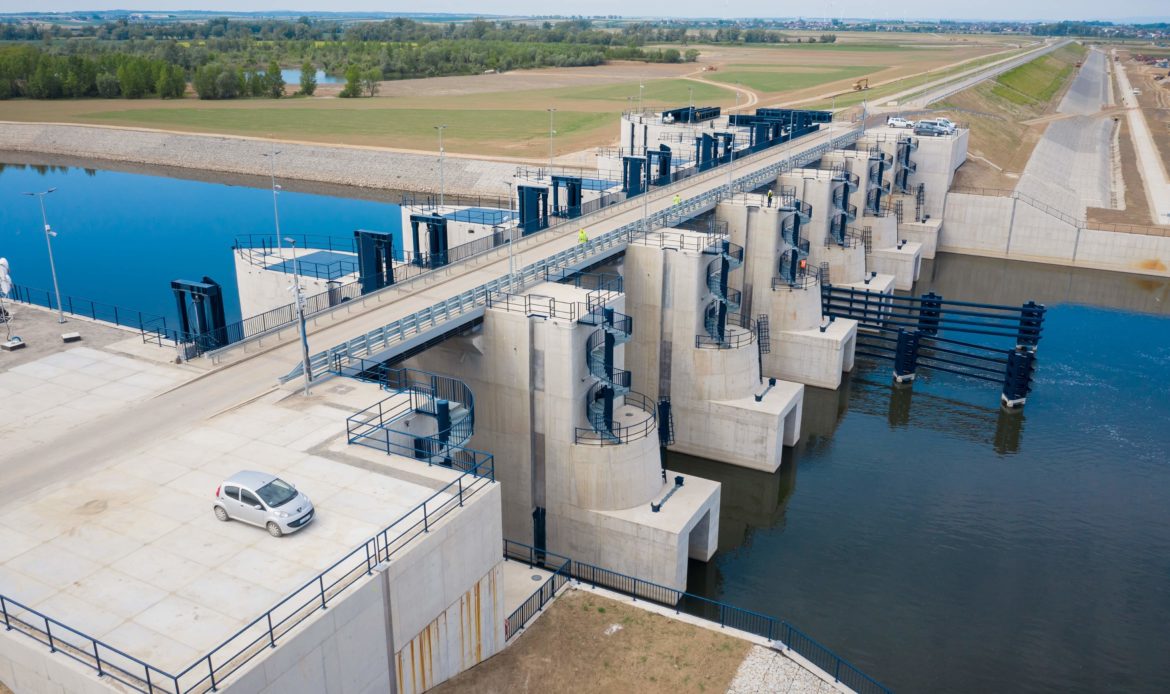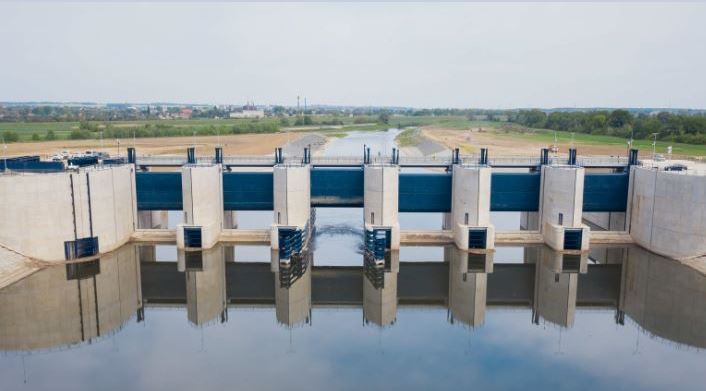The construction of the Racibórz Dolny Reservoir, which will protect 2.5 million inhabitants of the three provinces along the Oder River from flooding, has just finished.: Silesian, Opole Voivodeship and Lower Silesia. We talk to the expert of Polish Waters, Wojciech Skowyrski, Director of the Department of Preparation and Implementation of Investments, about the creation of the reservoir and its operation.
Over 20 years ago, the Millennium Flood swept through southern Poland, which culminated in the flooding of 60% of Racibórz. Can the inhabitants of these areas feel safe now, after the construction of the reservoir?
Yes, because we built it to be able to reduce the flow in the river during the flood wave. The reservoir in Racibórz is the so-called polder, i.e. a dry flood protection reservoir, the task of which is to absorb excess water and mitigate the flood wave to such a level that it doesn’t pose a threat to the inhabitants. We know that the embankments below the reservoir are able to provide protection against water with a flow of approximately 2,300 m3 / s. However, we will control the outflow so as to reduce the flow below the tank to 1210 m3 / s, i.e. twenty-year-old water. This is best explained with an example: let’s assume that the inflow of water from the upper Oder begins to increase. As long as it stays at the aforementioned value of 1210 m3 / s, we do nothing, but if it rises, we start to reduce it, or “choke the wave”. We rely on forecasts prepared by IMGW, which are updated every few hours. It should be noted that in the case of a flood wave, not only its size is important, but also its volume. When the inflow to the reservoir exceeds 2400 m3 / s, e.g. up to 3120 m3 / s (this was exactly what it was during the flood in 1997), we will throttle the wave more and more intensively until the outflow from the reservoir does not exceed 1600 m3 / s, which is a safe value in terms of the capacity of the Odra valley below.
What is flood wave suppression?
In the tank, and more precisely on the overflow and drainage structure, there are gates and bottom outlets. They form a system that we can maneuver automatically. When the water level rises, we close the gates one by one – the entire procedure is specified in the Water Management Manual. This is to prevent more water from flowing out of the tank than we want. This is how we maneuver the valves and close them in such a sequence to obtain a safe water flow. We’re in a good position because we carefully measured the flood wave of 1997: we know when it started, how long it lasted, what volume it had and when it began to recede. Wave suppression is pure math: let’s say a flood wave begins to decline to 900 m3 / s. We can still discharge 1210 m3 / s. Thanks to the fact that approx. 310 m3/s more water drains than arrives the tank is slowly being emptied.
What happens to the drained water?
It drops to the same level as before the flood, i.e. it returns to the riverbed. The canopy of the reservoir is equipped with a system of drainage ditches, which allow the water to drain into the bed even from stagnation that could be formed outside the main bed.
Currently, the canopy of the reservoir can absorb 185 million m3 of water, but it is to be dredged to 300 million m3. How long can dredging take?
About 10 years. There are huge layers of very good quality gravel in the reservoir’s canopy – it is estimated that it can be as much as 100 million m3 of aggregate. Taking into account the price of the gravel – there are billions of zlotys in the canopy of the reservoir to extract. Currently, several companies are working there, extracting it, while deepening the canopy of the reservoir and increasing its so-called flood reserve – that is, the amount of water that the reservoir can accept and hold. We would like the gravel extraction to end when the reservoir is a dry reservoir, because in the future we plan to transform it into a wet reservoir, which will not only protect against flooding, but also collect water during droughts.
In the front dam of the reservoir there is an overflow and drainage structure, which the designers call its “heart”. Where does this comparison come from?
The overflow and drainage structure is the most important part of the tank, it’s it that determines the amount of water outflow from the tank. Like the heart in the human body, it controls many processes. Located in the frontal dam, it controls flow like the valves in the heart. The chambers are the canopy of the reservoir. When there is no tide, this part of the reservoir ensures that the water can flow freely along the riverbed, while when the flow of water increases, it controls it’s outflow in an appropriate manner. The building was constructed in such a way that it also allows the passage of shipping vessels. Thanks to the overflow and drainage structure, it will also be possible to increase the water flow in the city Odra, if necessary. Successful catching of the flood wave depends on the work of this structure.
There are also two pumping stations: Lubomia and Buków around the reservoir. What is their job?
The pumping stations are located at the right-side dam of the reservoir. There’ re watercourses there that carry water to the Odra River. At the moment when the water level in the Odra River starts to rise, it wouldn’t be possible to drain the water by gravity, so it would back up and cause local flooding. But that’s when the pumping stations will come into action: they will be turned on to artificially raise the water level and throw it into the main tank. The pumping stations do not run non-stop – they are started only when necessary. However, thanks to the fact that they were built, the inhabitants of the areas adjacent to the reservoir are additionally protected.
The source information shows that the assumptions concerning the construction of the reservoir in Racibórz date back to the beginning of the 20th century. The inhabitants had to wait for it a bit. What was the reason for this?
Indeed, the construction of the reservoir was planned more than 100 years ago, after the flood in 1880. The first plans were created in the 1960s but were never implemented due to the high costs of such an investment. Only after the Tysiąclecia Flood in 1997, the subject was returned to. The first polder projects were created in 2004, but there was a problem with the expropriation of land. The entry into force of the special anti-flood act in 2010 facilitated the investment preparation process. Racibórz was included in the Odra River Basin Flood Protection Project and became the flagship investment of this project. Funds for its construction were obtained from many sources, including the World Bank, the Council of Europe Development Bank, the European Union or the National Fund for Environmental Protection and Water Management.
Speaking of residents, the construction of the reservoir in this place required the resettlement of over 700 people. It must have aroused a lot of emotions …
Such situations are always difficult, because the interests of many parties have to be reconciled. The public consultations took a long time. Representatives of the local government understood how important it’s to build a reservoir in this place: after all, the safety of not only Racibórz, but also Kędzierzyn Koźle, Opole and Wrocław depends on it. In the end, the inhabitants agreed to expropriation and relocation – this is how the new village of Nieboczowy was established, which was built from the very beginning, in the areas where there used to be fields. The village has a modern infrastructure – sports fields, parks, a church. Even the cemetery has been moved! The residents were free to decide where they would be moved, how their houses and the housing estate built for them would look like. And although the idea seemed breakneck at the beginning, it was successfully implemented.
You mentioned the planned transformation of the reservoir in Racibórz from dry to wet. How realistic are these plans?
The climate forecasts leave no room for illusions: the torrential rains causing the floods will alternate with long periods of drought. Therefore, these phenomena need to be considered together – we have to catch water when it falls and give it back when it is scarce. The only solution is to collect water in retention reservoirs, and the reservoir in Racibórz will be perfect for this. First of all: we can collect water in it and supply it to the Oder river during drought. This would have a positive impact not only on agriculture, but also on the economy, because Racibórz, as an accumulation reservoir, would improve the navigability of the river (currently low water levels often make navigation difficult). Secondly, the water stored in the reservoir could be used for energy purposes (hydropower plant). However, all this takes time. For the next five years, we will not be able to transform the reservoir anyway, because we are bound by the so-called project durability period when no changes are allowed. A lot of work is needed to turn a dry tank into a wet one. We must, among others make a lock, because there are plans to build the Odra-Danube waterway, strengthen the insurance of the water slopes around the reservoir, make fish passes, etc. Converting the reservoir is a complicated process that may take up to 10 years.
Opponents of this investment claim that the transformation of Racibórz from a dry into a wet reservoir will reduce its flood protection capacity. There are also allegations that the course of the Odra River was changed during the construction of the reservoir.
The change in the course of the Odra River concerned a section of only a few hundred meters and it was a minimal change, which did not disturb the biological life in and around the river in any way. When Racibórz becomes a wet reservoir, by adopting the appropriate Normal Water Level (NPP), we will maintain its flood retention capacity. At the same time, we will be able to mitigate the effects of a possible hydrological drought, which is also very much needed.
Interviewed by: Jowita Hakobert from the Social Communication Department of PGW Wody Polskie

Racibórz Dolny flood control reservoir
Investment cost: approx. 2 billion PLN
Sources of financing: World Bank, Council of Europe Development Bank, European Union, National Fund for Environmental Protection and Water Management, funds from the state budget
Contractors: consortium of Budimex SA (leader) and Ferrovial Agroman SA
Object capacity: 185 million m 3
Polder area: over 26 km 2
Length of dams around the reservoir: 22 km
Flood protection area: 600 km 2
Objective: flood protection of 2.5 million inhabitants of three voivodeships: Silesian, Opole voivodeships and Lower Silesia.
Operation: the polder enables the flattening of the flood wave and delays the moment when the Oder wave reaches the mouth of the Nysa Kłodzka river, thus reducing the probability of the overlapping of two wave culminations (which took place during the Tysiąclecia Flood in 1997).

